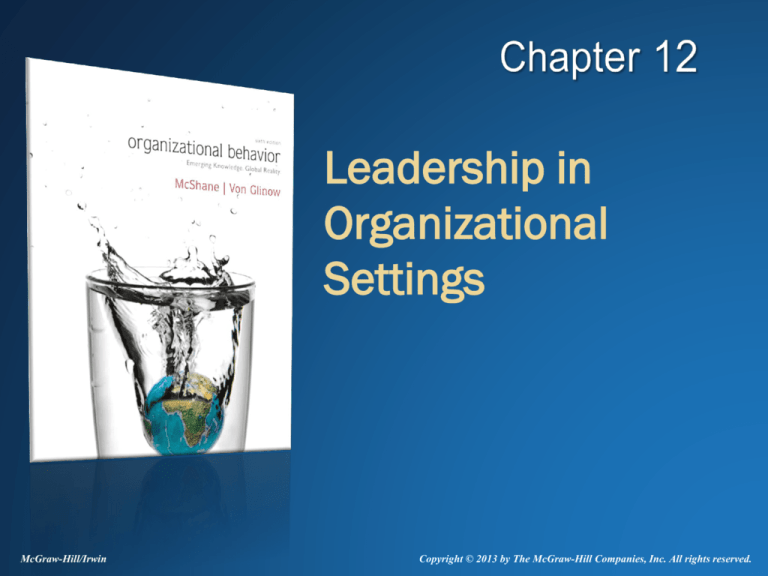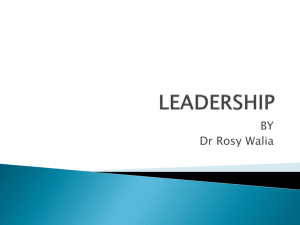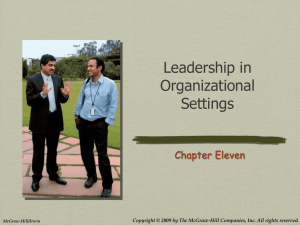
Leadership in
Organizational
Settings
McGraw-Hill/Irwin
Copyright © 2013 by The McGraw-Hill Companies, Inc. All rights reserved.
The Leadership of Steve Jobs
During his life, Steve Jobs won
numerous awards for his
transformational and charismatic
leadership. The co-founder of
Apple, Inc. and Pixar animation
Studios was equally renowned as
a demanding perfectionist with
less-than-ideal people skills.
12-2
Leadership Defined
Leadership is the ability
to influence, motivate,
and enable others to
contribute toward the
effectiveness of the
organizations of which
they are members
12-3
Shared Leadership
The view that leadership is broadly distributed,
rather than assigned to one person, such that
people within the team and organization lead
each other.
• Employees champion change, ideas, etc.
Shared leadership requirements:
• Formal leaders willing to delegate power
• Collaborative culture – employees support each
other
• Employees able to influence others
12-4
Perspectives of Leadership
Competency
Perspective
Implicit
Leadership
Perspective
Leadership
Perspectives
Transformational
Perspective
Behavioral
Perspective
Contingency
Perspective
12-5
Competency Perspective
Personal characteristics that lead to superior
performance in a leadership role
Several competencies now identified as key
influences on leadership potential and of
effective leaders
12-6
Eight Leadership Competencies
Personality
• Extroversion, conscientiousness
(and other personality dimensions)
Self-concept
• Positive self-evaluation
• High self-esteem and self-efficacy
• Internal locus of control
Drive
Integrity
• Inner motivation to pursue goals
• Inquisitiveness, action-oriented
• Truthfulness
• Consistency in words and actions
more
12-7
Eight Leadership Competencies
(con’t)
Leadership
Motivation
• Motivation to lead others
• High need for socialized power
Knowledge of
the Business
• Understands external environment
• Aids intuitive decision making
Cognitive/
Practical
intelligence
• Above average cognitive ability
• Able to solve real-world problems
Emotional
Intelligence
• Perceiving, assimilating, understanding,
and regulating emotions
12-8
Authentic Leadership at TNT
TNT, the Netherlands-based
express and mail delivery
services company, relies on
“honesty, authentic leadership,
and truly connecting with staff” to
keep the firm humanized. “What
you can do as a company is
emphasize that authentic
leadership is key and explain
what it entails” says TNT’s head
of human resources.
12-9
Authentic Leadership
Know Yourself
Be Yourself
• Engage in selfreflection
• Develop your own
style
• Feedback from
trusted sources
• Apply your values
• Know your life story
• Maintain a positive
core self-evaluation
12-10
Competency Perspective Limitations
1.
Implies a universal approach
2.
Alternative combinations of competencies
might work just as well
3.
Leadership is relational, not just something
within the person
4.
Competencies refer to leadership potential,
not performance
12-11
Leader Behavior Perspective
Task-oriented behaviors
• Assign work, clarify responsibilities
• Set goals and deadlines, provide feedback
• Establish work procedures, plan future work
People-oriented behaviors
• Concern for employee needs
• Make workplace pleasant
• Recognize employee contributions
• Listen to employees
12-12
Leader Behavior Perspective
Limitations
These categories mask subcategories of
leader behavior that may be distinct
Assumes best leaders display a high level of
both people-oriented and task-oriented styles
• But best style seems to depend on the situation
12-13
Servant Leadership
Leaders serve others toward their need
fulfillment, personal development, and
growth
Described as selfless, egalitarian, humble,
nurturing, empathetic, and ethical coaches
Three main features:
1. Natural calling to serve others
2. Maintain a humble, egalitarian, accepting
relationship
3. Anchor decisions/actions on ethical principles
12-14
Anne Sweeney’s Path-Goal
Leadership
Disney/ ABC executive Anne
Sweeney has an uncanny ability to
provide both task-oriented and
people-oriented leadership.
“There's great resolve and strength
there.”
“Anne draws upon her optimism and
her grace in keeping her focus firmly
on the future.”
“[She] asks the tough questions. . . .
It trains you to anticipate it.”
“She's very concerned about the
people who work for her.”
12-15
Path-Goal Leadership
Effective leaders provide the
information, support, and
other resources, and ensure
that rewards are linked to
good performance
Several employee and
situational contingencies to
determine the best leader
style
12-16
Path-Goal Leadership Styles
Directive
• Provide psychological structure to jobs
• Task-oriented behaviors
Supportive
• Provide psychological support
• People-oriented behaviors
Participative
• Encourage/facilitate employee involvement
Achievement-oriented
• Encourage peak performance through goal setting and
positive self-fulfilling prophecy
12-17
Path-Goal Leadership Model
Employee
Contingencies
Leader
Behaviors
•
•
•
•
Leader
Effectiveness
• Employee
motivation
Directive
Supportive
Participative
Achievementoriented
• Employee
satisfaction
• Acceptance of
leader
Environmental
Contingencies
12-18
Path-Goal Contingencies
Skill and experience
• Low: directive and supportive leadership
Locus of control
• Internal: participative and achievement leadership
• External: directive and supportive leadership
Task structure
• Nonroutine: directive and/or participative leadership
Team dynamics
• Low cohesion: supportive leadership
• Dysfunctional norms: directive leadership
12-19
Other Contingency Leader Theories
Situational Leadership Model
• Four styles: telling, selling, participating, delegating
• Best style depends on follower ability/motivation
• Popular model, but lacks research support
Fiedler’s Contingency Model
• Leadership style is stable -- based on personality
• Best style depends on situational control
• Theory has problems, but uniquely points out that
leaders have a preferred style, not very flexible
12-20
Leadership Substitutes
Contingencies that limit a leader’s influence
or make a particular leadership style
unnecessary
• e.g.: Training and experience replace task-oriented
leadership
Research evidence: substitutes help, but
don’t completely substitute for real leadership
12-21
Transformational, Managerial, and
Transactional Leadership
Transformational leadership
• Change agents – transforming the
organization to fit environment
Managerial leadership
• Improving employee performance
and well-being in the current
situation
• Applies contingency leadership
theories (e.g. path-goal)
Transactional leaders
• Influencing followers through
rewards, penalties, and
negotiation
Courtesy of Microsoft
12-22
Transformational v. Charismatic
Leaders
Some leadership models say charismatic
leadership is essential for transformational
leadership
Emerging view -- charisma differs from
transformational leadership
Charisma is a personal trait that provides
referent power
• Doesn’t necessarily attempt to change the organization
Transformational leadership is a set of behaviors
to bring about change
12-23
Transformational Leadership Model
Build
commitment
to the vision
Develop
a strategic
vision
Elements of
Transformational
Leadership
Model the
vision
Communicate
the vision
12-24
Transformational Leadership
Elements
Create a strategic vision
• Image of company’s attractive
future
• Motivates and bonds employees
• Vision may originate from the leader,
employees, or other stakeholders
Develop
a strategic
vision
Elements of
Transformational
Leadership
Communicate
the vision
Communicate the vision
• Frame message around a grand
purpose
• Shared mental model of the future
• Use symbols, metaphors, symbols
12-25
Transformational Leadership
Elements (con’t)
Model the vision
• Walk the talk
• Symbolize/demonstrate the
vision through behavior
• Employees trust leader more
Build
commitment
to the vision
Develop
a strategic
vision
Elements of
Transformational
Leadership
Model the
vision
Communicate
the vision
Build commitment to the vision
• By communicating and modeling the vision
• Through employee involvement in shaping
the shared vision
12-26
Evaluating Transformational Leadership
Transformational leadership is important
• Higher employee satisfaction, performance, org
citizenship, creativity
Transformational leadership limitations
• Risk of circular logic
- Some research defines transformational leaders by
their success rather than their behavior
• Universal theory
- Need a contingency-oriented theory
- Need to recognize cultural differences
12-27
Implicit Leadership Perspective
Follower perceptions of characteristics of
effective leaders
1.
Leadership prototypes
• Preconceived beliefs about the features and
behaviors of effective leaders.
2.
Romance of leadership effect
• Amplify effect of leaders on organizational results
• Fundamental attribution error
• Need for situational control
12-28
Leading with Ubuntu Values
Barloworld Logistics CEO Isaac
Shongwe is keen to imprint
Africa’s unique ubuntu value
throughout the company’s
operations in 26 countries.
Ubuntu is the notion of that
each of us is a person through
others. Thus, ubuntu calls for
leadership that emphasizes
mutual respect, tolerance, and
forgiveness.
12-29
Cultural Issues in Leadership
Societal cultural values and
practices affect leaders:
• Shape leader’s values/norms
• Influence decisions and actions
• Shape follower prototype of effective
leaders
Some leadership styles are
universal, others differ across
cultures
• “Charismatic visionary” seems to be
universal
• Participative leadership works better
in some cultures than others
12-30
Gender Issues in Leadership
Male and female leaders have similar taskand people-oriented leadership
Participative leadership style is used more
often by female leaders
Evaluating female leaders
• Still receive negative evaluations as leader due to
prototypes and gender stereotypes
• But evidence that they are good at emerging
leadership styles (coaching, teamwork)
12-31
Leadership in
Organizational
Settings







